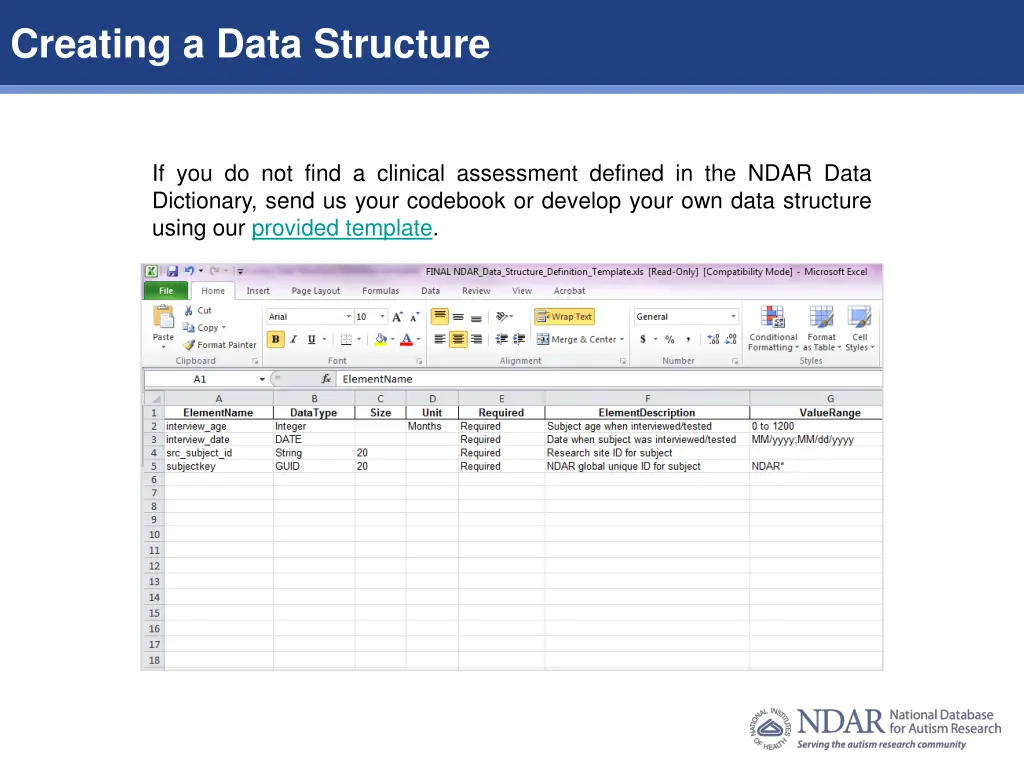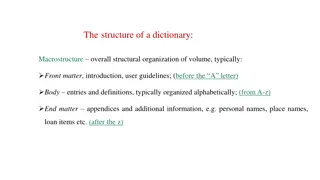
Data Structure Creation Guidelines for Clinical Assessments
Explore the comprehensive guidelines for creating a data structure to define clinical assessments when not found in the NDAR Data Dictionary. Learn about data types, value ranges, required data elements, formatting and organization, naming conventions, and more. Utilize the provided templates and images to develop a structured approach for data collection and analysis.
Download Presentation

Please find below an Image/Link to download the presentation.
The content on the website is provided AS IS for your information and personal use only. It may not be sold, licensed, or shared on other websites without obtaining consent from the author. If you encounter any issues during the download, it is possible that the publisher has removed the file from their server.
You are allowed to download the files provided on this website for personal or commercial use, subject to the condition that they are used lawfully. All files are the property of their respective owners.
The content on the website is provided AS IS for your information and personal use only. It may not be sold, licensed, or shared on other websites without obtaining consent from the author.
E N D
Presentation Transcript
Creating a Data Structure If you do not find a clinical assessment defined in the NDAR Data Dictionary, send us your codebook or develop your own data structure using our provided template. Data Structures | Data Elements 1
Data Types Data elements fall into following categories: Integer: a whole number (not a fractional number) that can be positive, negative, or zero Float: a number that contains a floating decimal point String: a text (a sequence of characters) Date: MM/DD/YYYY GUID: special subject s identifier File: file(s) linked to data being submitted Data Structures | Data Elements 2
Value Ranges A value range is the acceptable values for a data element. Multiple values must be separated by a semicolon. Ranges of values should be separated with two colons. A valid value must match the data type of the data element. For example, if the data element is an integer, it is not appropriate to have a value range containing letters. Data Structures | Data Elements 3
Formatting and Organization The following are required data elements and must be included in a data structure. Data Structures | Data Elements 4
Formatting and Organization Assessment scores always be listed as required elements. *from the Autism Diagnostic Observation Schedule Module 2 Data Structures | Data Elements 5
Naming Elements Element names should be created based on a combination of the assessment name and question number. For longer assessments with multiple sections, we recommend including the title of the corresponding section. Element names are limited to 30 characters. *from the Early Childhood Behavior Questionnaire Assessment abbreviation Question number *from the Ages and Stages Questionnaires Section name Subject s age and question number Data Structures | Data Elements 6
Naming Elements When creating a new data structure, please reuse as many data elements as possible from the Data Dictionary. *from the Background History Form *from Demographics Data Structures | Data Elements 7
Naming Elements To find existing elements, please refer to Manage Data Elements in the NDAR portal. Once logged into the portal, click on Data Dictionary in the Menu bar. Data Structures | Data Elements 8
Naming Elements On the right sidebar, click on Manage Data Elements. Data Structures | Data Elements 9
Naming Elements Here you can search through all of the existing elements. Data Structures | Data Elements 10
Translation If you have an assessment defined in your system and have never used NDAR s names, please use Alias Mapping to connect your names to NDAR s. If you have valid values in your system that are not in the NDAR Data Dictionary, we can create translations rules to accept your values. Data Structures | Data Elements 11
Review Once complete, send us your txt or csv file for review. Please also provide a pdf version of the assessment with a description. Please let us know if you want to see your lab name associated with provided data structure. Data Structures | Data Elements 12
Need Help? Each data structure is reviewed by NDAR staff prior to publication in the Data Dictionary. If you need assistance, please contact the NDAR Help Desk at NDARHelp@mail.nih.gov. Data Structures | Data Elements 13






















